Archive for the ‘Roof Materials’ Category
Concrete Roof Tile

Concrete roofs have gained popularity in the roofing field. It offers excellent wind, hail and fire resistance and installs similarly to clay tiles and slate. Concrete roof tile is made of sand, cement and water; exact ingredients vary with each manufacturer.
Concrete tiles are typically made into flat shakes instead of contoured clay like tiles. Although you can special order contoured shapes of concrete tile. Some manufacturers even make tiles that mimic wood in color and texture.
Smog Eaters
Entering the market is a ‘smog eating’ concrete tile, using a catalyst embedded in the upper part of the roof tile. The tile speeds up oxidation reducing nitrogen oxide when exposed to sunlight. The tile works similar to how a catalytic converter does in a car, protecting the air that we breathe.
Concrete tiles are heavy, about the same weight as clay tile. Some manufactures are making concrete tiles that are fortified with wood fibers and polymers to reduce overall weight without compromising durability. Concrete tiles offer about the same performance characteristics of clay tiles or slate but with lower overall installation costs.
Lasts a Lifetime
The National Association of Home Builders conducted a study in 2007 and determined concrete tile is one of only three roofing materials that will last a life time. Clay tile and copper are the other two materials; both products are more expensive than cement.
One consideration is although a concrete tile roof is expected to last 50 years, the underlayment may not last that long. Ensure your roofers are using quality underlayment, batten systems and flashings.
Concrete tiles are generally more resistance to damage from hail than any other roofing material, they are also easy to replace if any tiles get broken.
Climate Conditions Influence Roof Choices
 Most people never think twice about the roof material used on their home. However, this decision shouldn’t be left up to tradition or history, but an intentional choice that maximizes the climate conditions where the home is located. Making a few adjustments to the type of roof product on a home can boost the energy efficiency of a home.
Most people never think twice about the roof material used on their home. However, this decision shouldn’t be left up to tradition or history, but an intentional choice that maximizes the climate conditions where the home is located. Making a few adjustments to the type of roof product on a home can boost the energy efficiency of a home.
Choosing Wisely
New roof installation is the best time to look into newer or alternative roof products. Areas with a lot of sunshine are at a unique advantage to benefit from solar roof panels. Installing a 10 by 10 foot solar panel can generate enough electricity to power the average American home. By eliminating the need for traditional energy sources a home can operate independently while saving money on utility bills and improving the environment. Just think what an entire city of solar roof panels could do for the environment?
Although sunny climates have the added benefit of making good use of solar panels, they also come with a cost. The heat index can reach staggering height in the summer months, making it harder for the home to stay cool. Stone tiles and lighter colored roof materials can help reflect the sun’s UV rays and keep the home cool. Further, many new roof products come with environmentally safe chemicals that can help deflect the heat and insulate the home.
Cold or rainy climates also come with their fair share of challenges. Heating bills in the winter months can reach hundreds of dollars in homes that do not have proper roof materials. A dark coated roof can help absorb heat and maintain the homes warm temperatures far better than a lighter colored roof. However, despite their light color metal roofs are a good choice in some cold climates where snow is a problem. These roofs are very durable and known for their ability to inhibit snow buildup along the roof. They also fair well in rainy climates where increased moisture has the potential to cause water damage.
EPDM Rubber Roofing
 Rubber membrane roofs are no longer exclusively used for commercial roofs when doing roof repair, with the do it yourself friendly versions on the market now, they are an excellent choice for nearly flat to flat roofs.
Rubber membrane roofs are no longer exclusively used for commercial roofs when doing roof repair, with the do it yourself friendly versions on the market now, they are an excellent choice for nearly flat to flat roofs.
Ethylene Propylene Diene Monomer (EPDM) or otherwise known as rubber roofing is installed in wide sheets using adhesive instead of being nailed in place.
Rubber roofing provides the best protection against leaks on a low pitched roof due to being seamless and easy to install.
The rubber membrane is available at most home centers in standard 10×20 or 20×100 foot rolls. When possible, buy a large enough sheet to cover your entire roof, it decreases the likelihood of leaks by eliminating seams. EPDM adheres with a liquid adhesive instead of being applied with a torch like other membrane systems.
Prepare the Roof Deck
To install the rubber membrane, prepare the deck by removing the previous roofing material and any flashings or protrusions to get it down the bare roof decking. Your roof deck must be clean and in good repair before you apply the EPDM. If your roof deck shows signs of minor wear or the surface is not smooth, you can apply a layer of high density fiberboard or insulated board. Avoid using products with a waterproof film or layer as the glue will not penetrate and adhere properly.
After the roof deck is ready, lay the sheets of rubber membrane out so they overlap the edges of the roof by 3 inches. Overlap additional sheets by 3 inches, make any cutouts so the membrane will lay flat and relax. If you need to go up any walls, allow the membrane to cover12 inches up so it can be adhered and sealed to the wall. Roll the membrane back and apply a liquid bonding adhesive to the roof deck. Next, press the membrane back into place and smooth out any air pockets. When the rubber sheets are glued into place, you can seal the overlapping seams with strips of soft seaming tape and a liquid primer. Reinstall any flashings, trim the rubber roof membrane around the roof edges and add any termination bars if needed.
EPDM usually carries a 20 year warranty against the weathering process and factory defects. One possible drawback is rubber roofing will be hot on your roof; the black color absorbs the heat instead of reflecting it away.
Asphalt Shingles vs. Architectural Shingles

Both types, asphalt and architectural shingles are suitable for roofing a properly constructed pitched roof without any further reinforcement. The shingles come in two, three or four tab cutouts in 3 foot strips. Three-tab is the most common for asphalt shingles. The tab cutouts are to mimic the shapes of slate tile or wood shakes. Both types of shingles come in a wide range of colors to match your siding and trim. You can also get specially treated shingles if you live in a damp climate to prevent algae and molds.
Asphalt three-tab roof shingles have layers of asphalt, a base sheeting of fiberglass or felt and covered by mineral granules. In the United States, the three-tab shingle has been the most popular roofing material. They are lightweight, reasonably priced and can last anywhere from 8 to 30 years. The three-tab shingle is relatively easy to install or repair. High quality asphalt shingles can be fairly maintenance free and offer fire and wind resistance.
Architectural Shingles
Architectural shingles or multi thickness asphalt shingles are other terms for laminated asphalt shingles. These shingles have the same material as the tree tab roof shingle but instead of a single shingle layer, two layers are bonded together to create a 3 dimensional appearance. Laminated shingles have wide randomly sized notches to look more like the inconsistencies of a cedar or shake roof.
Laminated shingles are heavier than standard asphalt shingles which gives them improved durability and wind resistance. Although they generally cost more, laminated shingles offer longer 30 to 50 year warranties.
Talking to a roofing professional can help you determine what are the best roofing materials for your home and climate.
Roofing Product Considerations
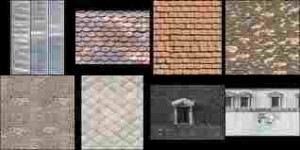
When choosing a roofing material, an important consideration is how much maintenance will the roofing material need. While some are nearly maintenance free, others require more effort into keeping your home attractive and dry. Roofing products are also greatly affected by the climate you live in. The lifetime of the roofing products also vary with the materials used.
Tile, metal, clay or concrete roofs generally do not need much maintenance. Clay, concrete and slate are the most durable roofing products. They are heavy and resist being blown off in high winds and usually carry a lifetime warranty. Metal roofs, although lightweight are extremely durable, a 50 year warranty is common.
Asphalt Shingles Most Common Roofing Material
The usual damage to roofing products is torn or cracked shingles, loose or missing asphalt shingles, wooden shakes and shingles. These products can be purchased in small amounts and individually replaced as needed on your roof. Wood shakes are available in different grades varying their durability. High quality shakes usually carry 50 year warranties. Asphalt shingles also vary widely in quality, they should last at least 20 years, while the thicker architectural shingles are warrantied up to 50 years.
Roll roofing has the shortest warranty, usually between 6 and 12 years. Small holes or blisters can occur in roll roofing, in most cases easily repaired by roofing cement and patches.
Talking to your roofing contractor will give you practical ideas and recommendations for the type of home you have and the climate you live in.
Asphalt Roll Roofing
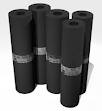
Asphalt roll roofing is one of the most inexpensive roofing materials available. It is used for low pitched roofs and is a common choice for porch, shed and garage roofs. Roll roofing is also a good choice if you need to protect a roof from the elements but you plan on installing a different roofing material later.
Roll roofing is quick and easy to install. Basically a roofer rolls the product onto your roof, then nails and seals the edges and overlaps with roofing cement. Your roof decking must be completely free of debris before installing the roll roofing. You should also install it during the warmer months, cold weather can cause the material to be brittle and crack.
Continuous Strip Of Asphalt Material
Rolls are typically 3 feet wide and 36 feet long. Asphalt roll roofing is like a continuous strip of tab-less asphalt shingles. Roll roofing is installed in overlapping layers similar to regular asphalt shingles. A wider overlap provides a double coverage effect.
Depending on the type you buy, asphalt roll roofing can be entirely covered in asphalt granules or only half the surface will be covered in granules. Depending if you are using single (the most common) or double coverage, the uncoated edge can be a few inches wide to half of the sheet. The uncoated section is covered in roofing cement for an improved seal.
Asphalt roll roofing does not last as long as asphalt shingles, however if installed correctly it can be more water tight. Since fewer nails are used in installation, the material is more likely to get wind up underneath and tear or blow off the roll roofing.
Moss Covered Roofs Not Always “Green”‘
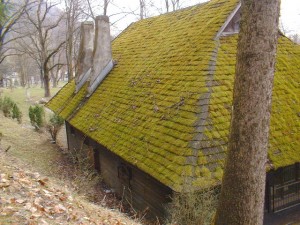 While much of the green roof movement has focused on natural, vegetative coverings as a main roof material, they aren’t always executed properly. Moss-covered roofs can be a great way to insulate a home and reduce environmental impact, but when the moss comes in addition to a non-green roof material, it can be more problematic than beneficial.
While much of the green roof movement has focused on natural, vegetative coverings as a main roof material, they aren’t always executed properly. Moss-covered roofs can be a great way to insulate a home and reduce environmental impact, but when the moss comes in addition to a non-green roof material, it can be more problematic than beneficial.
Roofing Made Not So Easy
In order for a moss-covered roof to be beneficial for both the homeowner and the environment it needs to be part of an intentional green roof. In many areas around the world where climates are moist or part of densely wooded forests, moss can infiltrate a traditional roof material, causing more harm than good.
Asphalt shingles, wood shakes and clay tiles are all roof materials that can be damaged by the growth of moss along the roof line. Since these traditional roofing materials are not made to support a moss covering, the increased moisture and growth patterns of the plant itself can damage the materials and result in the need for roof repair.
Metal roofs are fairly resistant to moss, or other plant, covering materials and do not require much maintenance in the way of preventative care. For other traditional roof materials, installing a strip of metal roof along the peak of the roof itself to discourage moss from growing along the roof line.
Roof Ventilation
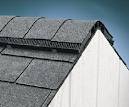
Regular maintenance can extend the life of your roof, so can insuring you have proper attic ventilation. Keeping the air flowing in your attic can minimize ice damning and lower your energy costs. Moisture produced inside the home may move to the attic if ceiling vapor barriers are not used. If moisture is not removed from the attic it can cause deterioration of your roofing materials.
The main goal is for attics to keep rain and snow out of your home and to be free of moisture problems and also the control of heat gain or loss.
Proper Air Flow
An effective roofing system will allow air to flow constantly through your attic, while keeping the inside temperature constant. If additional air flow is needed, there are temperature controlled power ventilators that can move the air in the attic.
Basically, for every 300 square feet of ceiling space, you need one square foot of attic ventilation. Gable vents may allow a small amount of air through your attic, roof line vents are effective for ventilation but usually not recommended due to leaking issues, and soffit vents may leave air trapped at the top of the attic. Ridge vents and soffit vents are generally the best and the most cost effective venting available according to most roofing experts.
Talk to A Roofing Professional
Talking to a roofing professional will help you determine if you have enough ventilation. Also check local building codes that may affect your home.
Roof Canales and Parapets

Drainage on a flat roof (or nearly flat) is very important. A minimal slope of ¼ is needed for water to drain off the roof properly to prevent buildup of water and leaks and other roof problems. Usually you are not seeing a flat roof, but a parapet or wall that contains the flat roof. A parapet is a low wall projecting from the edge of a roof, platform or terrace.
Drain spouts that protrude through the roof parapets are called canales. Canales are commonly made of wood reinforced with a metal lining. Southwestern adobe style flat roofed homes traditionally use canales instead of gutters to drain water from a flat roof. Parapets are very common in London; in 1707 projecting wooden eaves were banned due to fire risk.
Typically Canales Will Drain 400 sf of a Roof
Sometimes heavy rain fall has trouble passing through the canales openings fast enough to prevent water from puddling on the roof. Regular yearly inspections of the canals can insure nothing is blocking them and they are in good condition. Also check where the roof meets the parapet to look for possible places for leaks that may need roof repair. Other ways to allow more water to drain is by making the opening in the parapet larger than the canals. Canales should be avoided on the north sides of roofs since the parapet can give too much shade causing freezing and ice blockage and damaging the roof.
You can prevent erosion in your yard from the canales drainage by using rain barrels under the spouts. The water saved can water your yards and growing beds and used for other non-potable water needs.
Flat Roof Materials, Not All Are Created Equal
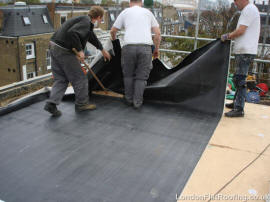 Flat roofs face many challenges. As they already must combat the effects that gravity can play with their lack of adequate slope, these roofs are generally the most challenging type of roof for homeowners to maintain.
Flat roofs face many challenges. As they already must combat the effects that gravity can play with their lack of adequate slope, these roofs are generally the most challenging type of roof for homeowners to maintain.
Finding someone for proper roof repair on a flat roof can also be challenging. While many roofers can repair a damaged flat roof, they may not use the best roof materials or even know about all the various flat roof material options.
Comparing Materials
The most important element to selecting the best flat roof material is water resistance and weather seal. It must be able to withstand lots of moisture without becoming damaged by standing water. Most flat roofs contain at least one type or rubber or plastic based sheathing to protect the underlying materials from water. It isn’t uncommon to find traditional asphalt shingles along a flat roof, which is not a problem as long as they are laid properly.
Flat Roofing Methods
One of the older methods for laying materials on a flat roof is constructed up roofing. This method consists of laying down multiple layers of tar and water resistant fabrics on the roof, which is then covered with gravel. This method is popular for its aesthetic appeal of the gravel, along with its affordability. However, the constructed up method often results in strong odors from the tar and gravel clogged gutters and drains.
The modified Bitumen method involves rolling a mineral covered surface onto the roof. The Bitumen mineral in the material reflects heat and sun rays, which can reduce the amount of energy consumed within the home to cool itself. This method is popular for its ability to be used by do-it-yourselfers.
One of the more weather resistant flat roof materials is the rubber membrane. This method involves laying a durable thick rubber on the roof. The rubber material makes it highly resistant to excess moisture and the nature of the surface makes leak detection a breeze.






